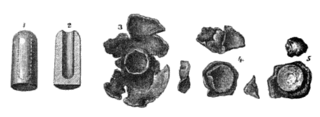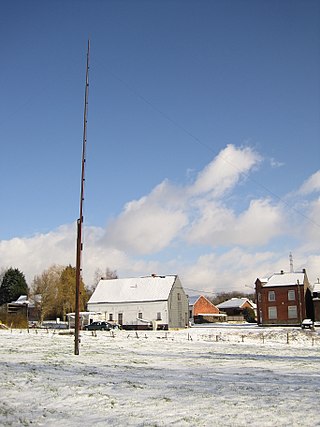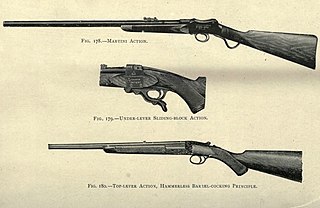
A rifle is a long-barreled firearm designed for accurate shooting and higher stopping power, with a barrel that has a helical or spiralling pattern of grooves (rifling) cut into the bore wall. In keeping with their focus on accuracy, rifles are typically designed to be held with both hands and braced firmly against the shooter's shoulder via a buttstock for stability during shooting. Rifles have been used in warfare, law enforcement, hunting and target shooting sports.

A shotgun is a long-barreled firearm designed to shoot a straight-walled cartridge known as a shotshell, which discharges numerous small spherical projectiles called shot, or a single solid projectile called a slug. Shotguns are most commonly used as smoothbore firearms, meaning that their gun barrels have no rifling on the inner wall, but rifled barrels for shooting sabot slugs are also available.

In firearm designs, the term single-shot refers to guns that can hold only a single round of ammunition inside and thus must be reloaded manually after every shot. Compared to multi-shot repeating firearms ("repeaters"), single-shot designs have no moving parts other than the trigger, hammer/firing pin or frizzen, and therefore do not need a sizable receiver behind the barrel to accommodate a moving action, making them far less complex and more robust than revolvers or magazine/belt-fed firearms, but also with much slower rates of fire.

Shooting sports is a group of competitive and recreational sporting activities involving proficiency tests of accuracy, precision and speed in shooting — the art of using ranged weapons, mainly small arms and bows/crossbows.
A muzzleloader is any firearm in which the user loads the projectile and the propellant charge into the muzzle end of the gun. This is distinct from the modern designs of breech-loading firearms, in which user loads the ammunition into the breech end of the barrel. The term "muzzleloader" applies to both rifled and smoothbore type muzzleloaders, and may also refer to the marksman who specializes in the shooting of such firearms. The firing methods, paraphernalia and mechanism further divide both categories as do caliber.
In the United Kingdom, access by the general public to firearms is subject to strict control measures. Members of the public may own rifles and shotguns, however, they must be properly licensed. Most handguns have been banned in Great Britain since the Dunblane school massacre in 1996. Handguns are permitted in Northern Ireland, the Channel Islands, and the Isle of Man which have their own applicable laws. Scotland imposes its own additional licensing requirements for airguns.

An elephant gun is a large caliber gun, rifled or smoothbore, originally developed for use by big-game hunters for elephant and other large game. Elephant guns were black powder muzzle-loaders at first, then black powder express rifles, then later used smokeless powder cartridges.
Sporting clays is a form of clay pigeon shooting, often described as "golf with a shotgun" because a typical course includes from 10 to 15 different shooting stations laid out over natural terrain.

A shotgun cartridge, shotshell, or shell is a type of rimmed, cylindrical (straight-walled) ammunition used specifically in shotguns. It is typically loaded with numerous small, spherical sub-projectiles called shot. Shotguns typically use a smoothbore barrel with a tapered constriction at the muzzle to regulate the extent of scattering.

Rabbiting is the sport of hunting rabbits. It often involves using ferrets or dogs to track or chase the prey. There are various methods used in capturing the rabbit, including trapping and shooting. Depending on where the hunting occurs, there may be licenses required and other rules in regards to methods being used.

The term express was first applied to hunting rifles and ammunition beginning in the mid-19th century, to indicate a rifle or ammunition capable of higher than typical velocities. The early express cartridges used a heavy charge of black powder to propel a lightweight, often hollow point bullet, at high velocities to maximize point blank range. Later the express cartridges were loaded with nitrocellulose-based gunpowder, leading to the Nitro Express cartridges, the first of which was the .450 Nitro Express.

Clay pigeon shooting, also known as clay target shooting, is a shooting sport involving shooting at special flying targets known as "clay pigeons" or "clay targets" with a shotgun. Despite their name, the targets are usually inverted saucers made of pulverized limestone mixed with pitch and a brightly colored pigment.

The double rifle, also known as a double-barreled rifle, is a rifle with two barrels mounted parallel to each other that can be fired simultaneously or sequentially in quick succession. Synonymous with big game hunting found primarily in Africa and Asia, the double rifle is a sporting weapon with very little military heritage.

In the United Kingdom, the term hunting with no qualification generally refers to hunting with hounds, e.g. normally fox hunting, stag (deer) hunting, beagling, or minkhunting, whereas shooting is the shooting of game birds. What is called deer hunting elsewhere is deer stalking. According to the British Association for Shooting and Conservation (BASC) over a million people a year participate in shooting, including stalking, shooting, hunting, clay shooting and target shooting. Firearm ownership is regulated in the UK by licensing. Provisions exist for those without a Firearm or Shotgun certificate to shoot under the supervision of a certificate holder.

Popinjay or papingo, also called pole archery, is a shooting sport that can be performed with either rifles or archery equipment. The object of popinjay is to knock artificial birds off their perches. The rifle form is a popular diversion in Denmark; a Scottish variant is also known. The archery form, called staande wip in Dutch language and papegai in French, is popular in Belgium, and in Canada among descendants of 20th-century Belgian emigrants; it is shot occasionally in the United Kingdom under the governance of the Grand National Archery Society. In Germany a traditional shooting at wooden birds placed on a high pole is called "Vogelschießen". These are carried out either with small bore rifles or crossbows.

50 meter rifle prone is an International Shooting Sport Federation event consisting of 60 shots from the prone position with a .22 Long Rifle (5.6 mm) caliber rifle.

50 meter rifle three positions is an International Shooting Sport Federation event, a miniature version of 300 meter rifle three positions. It consists of the kneeling, prone, and standing positions, fired in that order, traditionally with 3×40 shots for men and 3×20 shots for women. In January 2018, the number of shots was equalised between genders with the Women's 3x20 being abolished in favour of a 3x40 match identical to the men's event. The caliber is .22 Long Rifle (5.6 mm).

The rook is a member of the family Corvidae in the passerine order of birds. It is found in the Palearctic, its range extending from Scandinavia and western Europe to eastern Siberia. It is a large, gregarious, black-feathered bird, distinguished from similar species by the whitish featherless area on the face. Rooks nest collectively in the tops of tall trees, often close to farms or villages; the groups of nests are known as rookeries.
Game preservation is maintaining a stock of game to be hunted legally. It includes:

The rook rifle, originally called the rook and rabbit rifle, is an obsolete English single-shot small calibre rifle intended for shooting small game, particularly rook shooting.
















